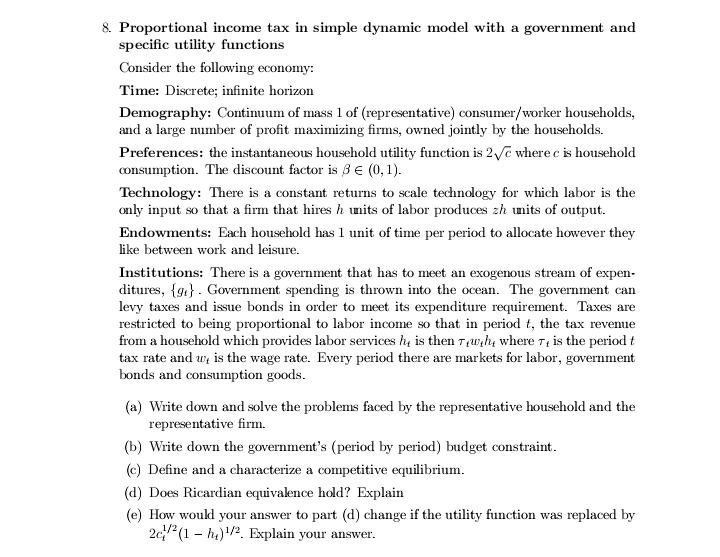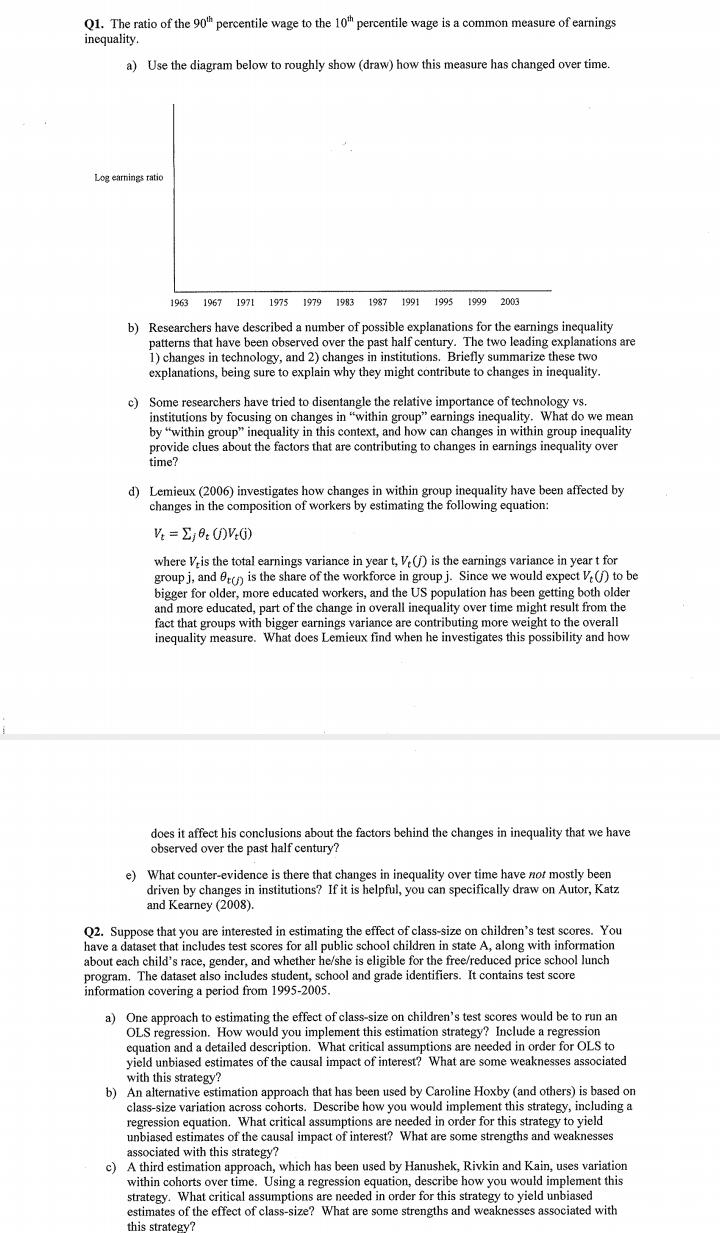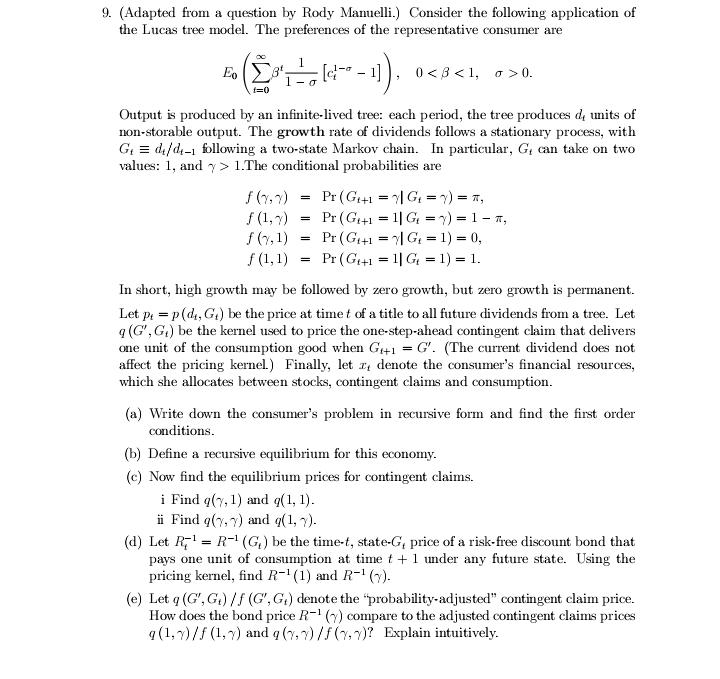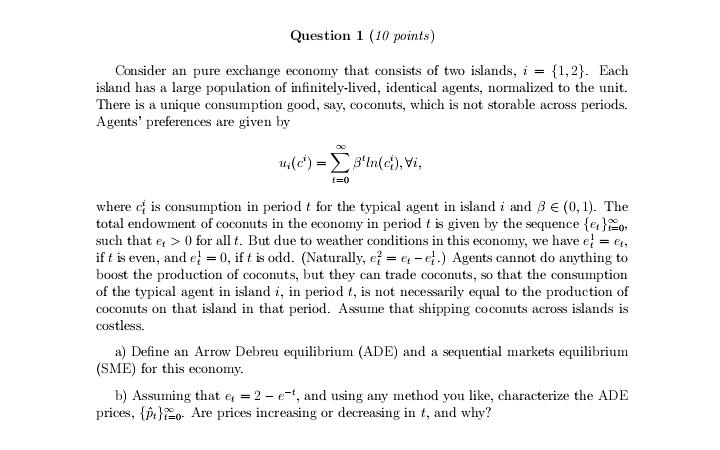




8. Proportional income tax in simple dynamic model with a government and specific utility functions Consider the following economy: Time: Discrete; infinite horizon Demography: Continuum of mass 1 of (representative) consumer/ worker households, and a large number of profit maximizing firms, owned jointly by the households. Preferences: the instantaneous household utility function is 2vc where c is household consumption. The discount factor is B e (0, 1). Technology: There is a constant returns to scale technology for which labor is the only input so that a firm that hires h units of labor produces zh units of output. Endowments: Each household has 1 unit of time per period to allocate however they like between work and leisure. Institutions: There is a government that has to meet an exogenous stream of expen- ditures, {g:} . Government spending is thrown into the ocean. The government can levy taxes and issue bonds in order to meet its expenditure requirement. Taxes are restricted to being proportional to labor income so that in period t, the tax revenue from a household which provides labor services hy is then Truth, where r, is the period t tax rate and my is the wage rate. Every period there are markets for labor, government bonds and consumption goods. (a) Write down and solve the problems faced by the representative household and the representative firm. (b) Write down the government's (period by period) budget constraint. (c) Define and a characterize a competitive equilibrium. (d) Does Ricardian equivalence hold? Explain (e) How would your answer to part (d) change if the utility function was replaced by 2c,"(1 - he)1/2. Explain your answer.Q1. The ratio of the 90" percentile wage to the 10" percentile wage is a common measure of earnings inequality. a) Use the diagram below to roughly show (draw) how this measure has changed over time. Log earnings ratio 1967 1971 1975 1979 1983 1987 1991 1995 1999 2003 b) Researchers have described a number of possible explanations for the earnings inequality patterns that have been observed over the past half century. The two leading explanations are 1) changes in technology, and 2) changes in institutions. Briefly summarize these two explanations, being sure to explain why they might contribute to changes in inequality. c) Some researchers have tried to disentangle the relative importance of technology vs. institutions by focusing on changes in "within group" earnings inequality. What do we mean by "within group" inequality in this context, and how can changes in within group inequality provide clues about the factors that are contributing to changes in earnings inequality over time? d) Lemieux (2006) investigates how changes in within group inequality have been affected by changes in the composition of workers by estimating the following equation: VI = [, 0: ( ) V.() where V, is the total earnings variance in year t, V, () is the earnings variance in year t for group j, and Orgy is the share of the workforce in group j. Since we would expect V, () to be bigger for older, more educated workers, and the US population has been getting both older and more educated, part of the change in overall inequality over time might result from the fact that groups with bigger earnings variance are contributing more weight to the overall inequality measure. What does Lemieux find when he investigates this possibility and how does it affect his conclusions about the factors behind the changes in inequality that we have observed over the past half century? e) What counter-evidence is there that changes in inequality over time have not mostly been driven by changes in institutions? If it is helpful, you can specifically draw on Autor, Katz and Kearney (2008). Q2. Suppose that you are interested in estimating the effect of class-size on children's test scores. You have a dataset that includes test scores for all public school children in state A, along with information about each child's race, gender, and whether he/she is eligible for the free/reduced price school lunch program. The dataset also includes student, school and grade identifiers. It contains test score information covering a period from 1995-2005. a) One approach to estimating the effect of class-size on children's test scores would be to run an OLS regression. How would you implement this estimation strategy? Include a regression equation and a detailed description. What critical assumptions are needed in order for OLS to yield unbiased estimates of the causal impact of interest? What are some weaknesses associated with this strategy? b) An alternative estimation approach that has been used by Caroline Hoxby (and others) is based on class-size variation across cohorts. Describe how you would implement this strategy, including a regression equation. What critical assumptions are needed in order for this strategy to yield unbiased estimates of the causal impact of interest? What are some strengths and weaknesses associated with this strategy? c) A third estimation approach, which has been used by Hanushek, Rivkin and Kain, uses variation within cohorts over time. Using a regression equation, describe how you would implement this strategy. What critical assumptions are needed in order for this strategy to yield unbiased estimates of the effect of class-size? What are some strengths and weaknesses associated with this strategy?& Consider an economy with a single representative consumer. The consumer's prefer- ences over consumption and labor (leisure) are: 00. The preference shifter , is a non-negative exogenous random variable governed by a Markov process with the stationary transition density f (0', (). The sole source of the single non-storable good is a representative farm that produces the good using labor and an everlasting tree. The farm's objective is to maximize each period's profits: max * = 11 - Wilt, 420 41 =4-", 0 0. Output is produced by an infinite-lived tree: each period, the tree produces d, units of non-storable output. The growth rate of dividends follows a stationary process, with G: = di/ do-1 following a two-state Markov chain. In particular, G, can take on two values: 1, and y > 1.The conditional probabilities are f (7,7) = Pr ( Git1 = \\| G( = ) = *, f (1, y) = Pr ( Git1 = 1/ G; = y) = 1-*, f (7,1) = Pr (Git1 = \\| G; = 1) = 0, f (1,1) = Pr (Gi+1 = 1/ G; = 1) = 1. In short, high growth may be followed by zero growth, but zero growth is permanent. Let p, = p(d, Go) be the price at time t of a title to all future dividends from a tree. Let q (G', G,) be the kernel used to price the one-step-ahead contingent claim that delivers one unit of the consumption good when Git1 = G'. (The current dividend does not affect the pricing kernel.) Finally, let z, denote the consumer's financial resources, which she allocates between stocks, contingent claims and consumption. (a) Write down the consumer's problem in recursive form and find the first order conditions. (b) Define a recursive equilibrium for this economy. (c) Now find the equilibrium prices for contingent claims. i Find q(y, 1) and q( 1, 1). ii Find q(7, 7) and q( 1, 7). (d) Let R71 = R- (G, ) be the time-t, state-G, price of a risk-free discount bond that pays one unit of consumption at time : + 1 under any future state. Using the pricing kernel, find R-1 (1) and R- (y). (e) Let q (G', G.) /f (G', G,) denote the "probability-adjusted" contingent claim price. How does the bond price R-(y) compare to the adjusted contingent claims prices q (1, 7)/f (1, v) and q(7, 7)/f(7, v)? Explain intuitively.Question 1 (10 points) Consider an pure exchange economy that consists of two islands, i = {1, 2}. Each island has a large population of infinitely-lived, identical agents, normalized to the unit. There is a unique consumption good, say, coconuts, which is not storable across periods. Agents' preferences are given by u(e') = [ s'In(c), vi, 1=0 where of is consumption in period { for the typical agent in island i and 3 e (0, 1). The total endowment of coconuts in the economy in period { is given by the sequence fen fen, such that er > 0 for all t. But due to weather conditions in this economy, we have ef = er, if t is even, and e, =0, if t is odd. (Naturally, e/ = e -e).) Agents cannot do anything to boost the production of coconuts, but they can trade coconuts, so that the consumption of the typical agent in island i, in period , is not necessarily equal to the production of coconuts on that island in that period. Assume that shipping coconuts across islands is costless. a) Define an Arrow Debreu equilibrium (ADE) and a sequential markets equilibrium (SME) for this economy. b) Assuming that e = 2 - e-', and using any method you like, characterize the ADE prices, { }fen- Are prices increasing or decreasing in t, and why
















